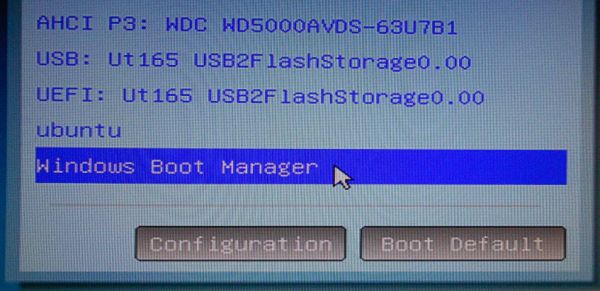UEFI固件下安装了windows7 ,安装Ubuntu双系统
现在网上大多数教程是按照BIOS固件的路子写的,已经不适合UEFI安装双系统了。
按照传统的教程总是安装不上或者找不到系统进入点。
按照这个教程安装好了。主要是bootloader要安装到系统原有的EFI系统分区。\boot 不再划分。
http://linuxbsdos.com/2014/05/30/dual-boot-ubuntu-14-04-and-windows-7-on-a-pc-with-uefi-firmware/
Dual-boot Ubuntu 14.04 and Windows 7 on a PC with UEFI firmware
This post shows how to dual-boot Ubuntu 14.04 and Windows 7 on a computer with UEFI firmware. Note that the computer I used for the tutorial is not an OEM one. Rather, it is a custom-built computer, with an ASRock motherboard and Intel Core i3 processor. However, if you follow this guide step-by-step, you should be able to use it to dual-boot Ubuntu 14.04 and Windows 7 on any computer with UEFI firmware on a single hard drive.
An assumption made here is that you have Windows 7 already installed on the target hard drive. However if necessary, you can always install it afresh. So based on that assumption, here are the steps involved:
- Recover space for installing Ubuntu 14.04 by shrinking the Windows 7 Cdrive
- Install Ubuntu 14.04 on the recovered space. This assumes that you’ve already downloaded an installation image of Ubuntu 14.04 and burned or transferred it to an appropriate installation media.
- Set the default boot manager for the computer
Before we proceed to the instructions, this screenshot shows the partitions that the Windows 7 installer will likely create, as seen from the Windows 7 partition manager. Note that the C drive is about 420 GB and the EFI partition is about 100 MB. In the first step of the installation process, space that will be used to install Ubuntu 14.04 will have to be recovered from theC drive.

This is what you’ll see from the Ubuntu 14.04 installer. It offers a much clearer detail about the layout of the number and type of partitions than the Windows 7 partition manager. /dev/sda1 is the 100 MB EFI partition that you saw in the previous screenshot.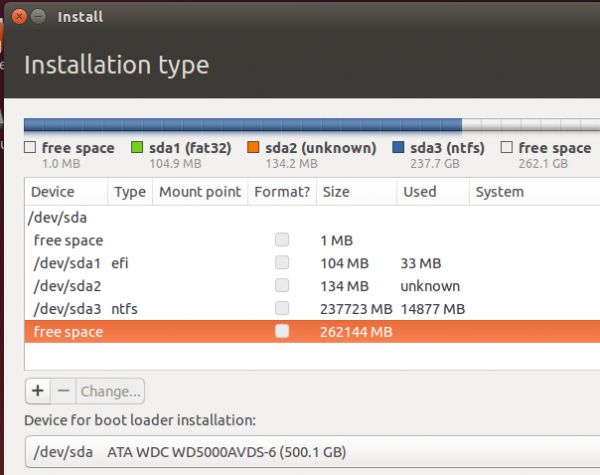
With all that introduction out of the way, let’s get this thing done.
Step 1. Shrink Windows 7’s C Drive: To shrink the C drive, launch the Windows 7 partition manager and right-click on the bar that represents theC drive. Select Shrink Volume from the context menu. You should be able to recover enough disk space to install Ubuntu. A detailed description of how to accomplish this step is available in this forum post.
Step 2. Install Ubuntu 14.04: Ubuntu 14.04 will be installed in the space that was recovered from step 1. To begin this step, reboot the computer with the installation media you created in the optical drive or in a USB port. Start the installer and click through until you get to the step shown in this screenshot. It is very likely that the installer will inform you that “This computer currently has no detected operating systems. What would you like to do?” Select the Something else option, then click Continue.
That should open the installer’s Advanced Partitioning Tool’s window. You should see all the partitions on the system, including the space that was recovered from Windows 7’s C drive. That space should be marked as “free space.” To start creating partitions to install Ubuntu 14.04, select it, then click on the + button directly below it.
That should open the installer’s partition editor. If you are new to the concept of disk partitions in Linux and creating partitions in Ubuntu Desktop, it is highly recommended that you read Guide to disks and disk partitions in Linux and How to install Ubuntu 14.04 on encrypted MBR partitions. For each partition that you’ll create at this step, all you need to modify are the values for “Size,” “Use as” and “Mount point.” And because a few of the partitions needed were already created during the installation of Windows 7, only partitions for / (root), /home and Swap will need to be created for Ubuntu 14.04 – in that order.
For the root partition, a disk space of 20 GB (20,000 MB) should be more than enough. The minimum required is actually 6.4 GB, so the extra should take care of future growth in disk usage. For file system (Use as), you may select the default (Ext4) or even btrfs. Be sure to select / from the “Mount point” menu. OK.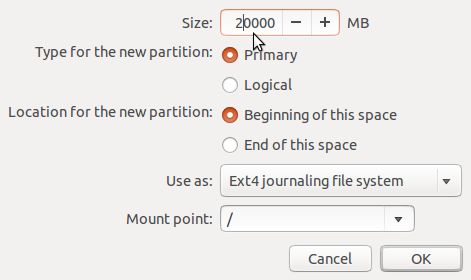
For the /home partition, assign the disk space you think you need and select /home for the mount point. OK.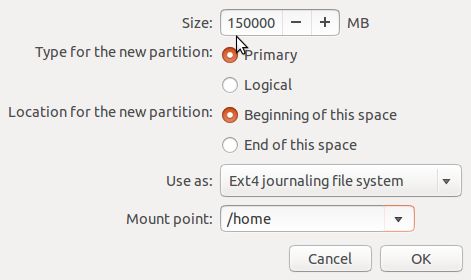
For the Swap partition, a size of 4 GB (4000 MB) should be enough. From the “Use as” menu, select swap area. OK.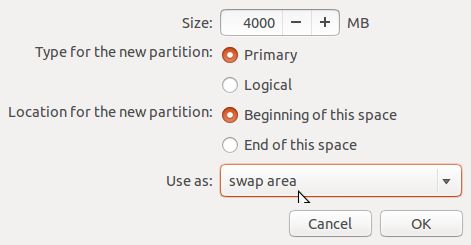
Back to the main partitioning window, you should see all the newly created partitions. Did you notice that we did not create a boot partition? That’s because on these systems, the EFI partition, which on the system used for this tutorial is /dev/sda1, serves as the boot partition. Boot files for GRUB will be installed there. GRUB (the GRand Unified Bootloader) is the boot program used by Ubuntu and virtually all Linux distributions. Before clicking Install Now, change the entry in the “Device for boot loader installation” from /dev/sda to /dev/sda1. Continue with the rest of the installation.
Step 3. Set the Default Boot Manager: After Step 2 has completed successfully, reboot the computer. Before it reboots into the default boot device, press the F key that will take you to the boot menu. For my computer, it is the F11 key. This screenshot shows the entries in the boot menu of the computer used for this tutorial. The AHCI P3: WDC W5000…entry is for the hard drive used for this installation. The OS entries areUbuntu and Windows Boot Manager. If you select the AHCI P3: WDC W5000… entry, the computer will not boot.
That was the case with my computer. To boot into Ubuntu 14.04 or Windows 7, select the appropriate OS entry. After verifying that you can boot into Windows 7 and Ubuntu 14.04, you should get into your system’s UEFI setup utility and set the default boot device to Ubuntu, which should have entries for Ubuntu 14.04 and windows 7 in the GRUB menu. You might want to read Boot managers and boot devices on a PC with UEFI firmwarefor a brief discussion of the subject in this step.
